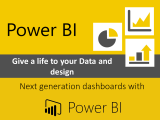Master Power BI Desktop for data analysis with hands-on assignments & projects from top-rated instructor.
Welcome to the best Power BI Desktop course
If you’re a data professional or aspiring analyst looking to learn the top business intelligence platform on the market, you’ve come to the right place.
Throughout the course, you’ll learn skills with hands-on projects and unique, real-world assignments.
This course is designed to follow the key stages of the business intelligence workflow, and simulate real-world tasks that data professionals encounter on the job:
STAGE 1: Connecting & Shaping Data
In this stage we’ll focus on building automated workflows to extract, transform, and load our project data using Power Query, and explore common data connectors, storage modes, profiling tools, table transformations, and more:
-
Data connectors
-
Storage & import modes
-
Query editing tools
-
Table transformations
-
Connecting to a database
-
Extracting data from the web
-
QA & Profiling tools
-
Text, numerical, date & time tools
-
Rolling calendars
-
Index & conditional columns
-
Grouping & aggregating
-
Pivoting & unpivoting
-
Merging & appending queries
-
Data source parameters
-
Importing Excel models
STAGE 2: Creating a Relational Data Model
In stage 2 we’ll review data modeling best practices, introduce topics like cardinality, normalization, filter flow and star schemas, and begin to build our AdventureWorks data model from the ground up:
-
Database normalization
-
Fact & dimension tables
-
Primary & foreign keys
-
Star & snowflake schemas
-
Active & inactive relationships
-
Relationship cardinality
-
Filter context & flow
-
Bi-directional filters
-
Model layouts
-
Data formats & categories
-
Hierarchies
STAGE 3: Adding Calculated Fields with DAX
In stage 3 we’ll introduce data analysis expressions (DAX). We’ll create calculated columns and measures, explore topics like row and filter context, and practice applying powerful tools like filter functions, iterators, and time intelligence patterns:
-
DAX vs. M
-
Calculated columns & measures
-
Implicit, explicit & quick measures
-
Measure calculation steps
-
DAX syntax & operators
-
Math & stats functions
-
Conditional & logical functions
-
The SWITCH function
-
Text functions
-
Date & time functions
-
The RELATED function
-
CALCULATE, FILTER & ALL
-
Iterator (X) functions
-
Time intelligence patterns
STAGE 4: Visualizing Data with Reports
Stage 4 is about bringing our data to LIFE with reports and dashboards. We’ll review data viz best practices, building and format basic charts, and add interactivity with bookmarks, slicer panels, parameters, tooltips, report navigation, and more:
-
Data viz best practices
-
Dashboard design framework
-
Cards & KPIs
-
Line charts, trend lines & forecasts
-
On-object formatting
-
Table & matrix visuals
-
Conditional formatting
-
Top N filtering
-
Map visuals
-
Drill up, drill down & drillthrough
-
Report slicers & interactions
-
Bookmarks & page navigation
-
Numeric & fields parameters
-
Custom tooltips
-
Importing custom visuals
-
Managing & viewing roles (RLS)
-
Mobile layouts
-
Publishing to Power BI Service







